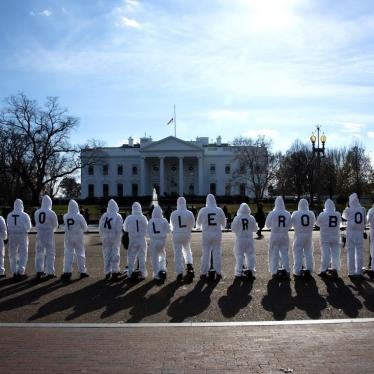For the Campaign to Stop Killer Robots, our preferred option for addressing the humanitarian and international security challenges posed by fully autonomous weapons—or “LAWS”—is for states to negotiate a legally-binding instrument to prohibit weapons systems that can select and engage targets without meaningful human control. The treaty should enshrine the principle that states should maintain meaningful human control over the use of force.
There are multiple advantages and benefits to creating such a ban treaty or protocol. A treaty would help satisfy mounting ethical, legal, humanitarian, operational, technical and other concerns raised by fully autonomous weapons. Here are nine reasons why a treaty is necessary:
1. To enhance and strengthen existing international humanitarian and human rights law. A new treaty would build on those areas of law and eliminate any doubts that fully autonomous weapons are incapable of abiding by the fundamental principles of international humanitarian and human rights law. These weapons fundamentally differ from other weapons and raise unique challenges. A treaty can unambiguously address the application of existing law to these weapons.
2. To clarify states’ obligations and make explicit the requirements for compliance. A new treaty would standardize rules across countries. Even states that do not immediately join the treaty would be inclined to abide by its prohibition due to the stigma associated with removing meaningful human control from weapons systems and the use of force. A binding, absolute ban on fully autonomous weapons would also be easier to enforce than a complex series of rules and regulations because it would be simpler and clearer and reduce the need for case-by-case determinations.
3. To make the illegality of fully autonomous weapons clear, especially in countries that do not conduct Article 36 legal reviews of new or modified weapons. A new treaty would also help to resolve the shortcomings of Article 36 reviews, which are only conducted by approximately 30 states, as reviewers follow varying standards, reviews can be narrow in their scope, and reviews are never publicly released.
4. To facilitate agreement on the legal definition of fully autonomous weapons and, in so doing, establish what is unacceptable about autonomy in weapons systems.
5. To help stop development before it goes too far and thereby avert an arms race and prevent proliferation, including by states with little regard for international humanitarian law or by non-state armed groups. The new treaty should prohibit not only use, but also development and production of fully autonomous weapons.
6. To close the accountability gap raised by fully autonomous weapons. There are currently insurmountable legal and practical obstacles that would, in most cases, prevent holding anyone responsible for unlawful harms caused by fully autonomous weapons. A treaty prohibiting killer robots could lead to national implementation laws criminalizing violations of the treaty, thereby facilitating enforcement.
7. To address the far-reaching moral and ethical objections raised over fully autonomous weapons, most notably their lack of judgment and empathy, threat to human dignity, and absence of moral agency.
8. To satisfy rising calls for regulation from states, industry, and civil society. This would help meet public expectations that governments will act preventively and address emerging technologies that raise a host of concerns.
9. To ensure continued research and development of beneficial civilian applications of new and emerging technologies including robotics and artificial intelligence, by providing clarity to tech companies and the financial institutions and investment communities that support them, and by ensuring their work is not tainted by the stigmatizing impact of autonomous weapons.
If states are serious about the Convention on Conventional Weapons being the appropriate forum to tackle concerns raised by fully autonomous weapons, then they should commit to move to a negotiating mandate at the Meeting of High Contracting Parties in November. The CCW is a flexible framework convention that was intended to prohibit or restrict the use of certain weapons which may be deemed to be excessively injurious or to have indiscriminate effects. A new protocol could confirm the areas of convergence captured by the “possible guiding principles” contained in the final report of the last annual meeting, which affirmed that “human responsibility for decisions on the use of weapon systems must be retained.”
There is, of course, precedent for a ban treaty, including ones negotiated outside of United Nations auspices. In the past, responsible states found it necessary to supplement existing legal frameworks for weapons that by their nature posed significant humanitarian threats, such as biological weapons, chemical weapons, antipersonnel mines, and cluster munitions. There is also precedent for such a preemptive ban in CCW Protocol IV prohibiting laser weapons designed to permanently blind human soldiers.
The Campaign to Stop Killer Robots cannot support alternative approaches that fall short of new international law, such as political declarations, guidelines, codes of conduct, compendiums of military “best practices,” and questionnaires. We highly doubt that such measures will satisfy public concerns.
This Group of Governmental Experts should agree to recommend that the CCW move to a negotiating mandate and not simply roll the current one over and consider options again. There is not time or money to waste on inconclusive talks that lead nowhere. If the CCW cannot deliver a negotiating mandate in 2019—after six years of work—it is time to look elsewhere.







